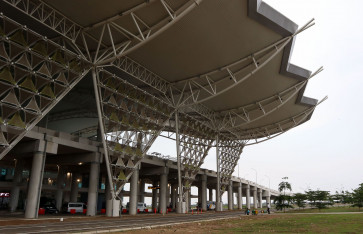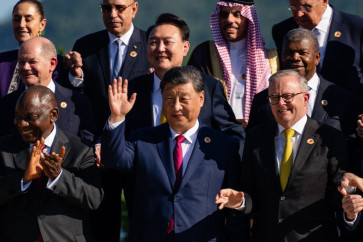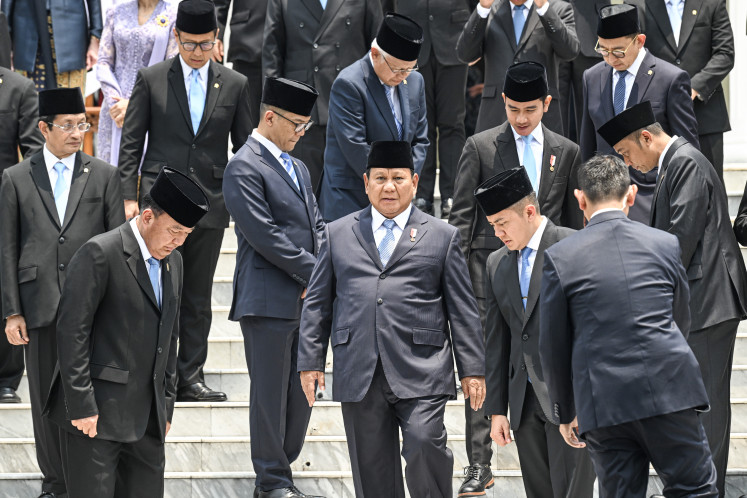Popular Reads
Top Results
Can't find what you're looking for?
View all search resultsPopular Reads
Top Results
Can't find what you're looking for?
View all search resultsBalinese artists showcase collective spirit
All with Love by Putu Eni Astiarini
Change text size
Gift Premium Articles
to Anyone
All with Love by Putu Eni Astiarini.
A collective of Bali-based artists, both old and new, has initiated an exhibition that bridges traditional and contemporary styles.
The paintings are both hilarious and unsettling at the same time.
One portrays a dark-skinned angel having a bubbly bath. Her wings are pressed against the head of a huge green bathtub that stands next to a calm swimming pool. Rows of palm trees and a range of mountain are seen in the distance.
It would be a perfect image of a tropical paradise if not for a strange looking figure at the bottom left of the painting. Hidden from the sight of the angel, the character — dressed in the red and blue superhero suit of Superman — is trying to snatch the angel’s undergarment away.
The scene was clearly inspired by a famous local folklore story about Rajapala, a young man who stole the garment of an angel when the latter was bathing in a secluded pond as a way to win her hand in marriage.
It was a tragic love story as the beautiful angel eventually found her garment and flew back to heaven, leaving Rajapala and their young daughter behind.
Mencuri Kedalaman Surga (Stealing Paradise) by I Wayan Gede Suanda.The painter, I Wayan Gede Suanda, an Ubud native known for his viral installation work Not For Sale set amidst the lush paddy fields of his native village, smiled mischievously when asked about Rajapala.
“Yes, that was the inspiration, but my story has a far worse ending than that of Rajapala,” he said.
The painting speaks about a paradise island that is being exploited — robbed, pillaged and ravaged — by “foreign superheroes”. It is also a lamentation on the lack of local heroes to protect Balinese angels, the visual metaphor for the island’s culture and nature.
Titled Mencuri Kedalaman Surga (Stealing Paradise) the painting is part of an ongoing exhibition held at the Kaktus Art and Connecting Space in Mertasari, Sanur.
The exhibition, called “April Mop”, features the works of 20 Bali-based artists, including well-known ones, such as Wiradana, Dolar Astawa, Made Duatmika, Ni Nyoman Sani and Romi Sukadana, as well as rising artists like Jango Pramartha, a prominent caricaturist who has recently experimented with fine arts.
About Nature Series by I Made Romi Sukadana.
The displayed works are not only a testament to the colorful landscape of the local painting world — the diversity in themes, techniques and aesthetic schools of the participating artists — but also, and more importantly, to the enduring collective spirit that binds them together.
For decades, the tension between traditional arts and modern arts had become one of the most talked about topics in Bali. The discourse often pit the collective, communal nature of the former against the individualism of the latter.
It was a misguided generalization driven by the fear that Balinese artists who embrace modernity would abandon or be insulated from their collective roots. This notion has been refuted by scores of Balinese artists, from Wianta and Gunarsa to Nuarta and Erawan, who created bodies of works that are distinctively Balinese and truly contemporary at the same time.
April Mop is another nail in the coffin that puts the generalization into a long slumber.
The displayed works show that rather than pulling the artists from their roots, the modern techniques and esthetics have instead provided them with a potent and relevant way to discuss, interpret and celebrate their cultural roots and their challenges.
Nasehat Tanpa Kata (Advice Without Words) by I Made Duatmika.Furthermore, the fact that the Kaktus Art and Connecting Space is a collective property — jointly owned, financed and managed by those 20 participating artists — is more evidence of their belief in the importance of communal values in modern art.
One of the founding members of Kaktus, I Made Arya Palguna, said that the birth of Kaktus in 2018 was spurred by a simple need to find a place to showcase their works.
“Bali has a limited number of galleries; thus, it was quite difficult for us to find an empty slot to exhibit our works,” he said.
They pooled their cash and leased a vacant property on Jl. Mertasari in Sanur. The area boasts expatriate residences, chic restaurants and some of Sanur’s best hotels.
They named the new place Kaktus after the cactus, a tough plant that could thrive even in a parched land, and they hosted their inaugural joint exhibition called “On Fire” in April 2018.
Save Culture #4 by I Made Dolar Astawa.Since the first joint exhibition, Kaktus has grown into a cultural hub, where artists, curators, social commentators and collectors share and discuss new ideas and collaborations.
The rent and operational costs of the space are financed by commissions from paintings sold in the exhibition, as well as from members’ contributions.
“There is a strong sense of solidarity and openness here. The atmosphere is also very supportive as we help each other in our creative journey. Critical comments on colleagues’ artworks or ideas are a major part of our daily bantering here,” a member, Ni Nyoman Sani, said.
In the near future, Kaktus is to launch collaborative exhibitions involving outside curators and artists, as well as an art residency and exchange program.
“Four of our members will travel to Busan this month to participate in an art fair and another participation is scheduled in June in Singapore,” Palguna said.
Taking a look: Exhibition visitors talk in front of a painting.— Photos by I Wayan Juniarta















